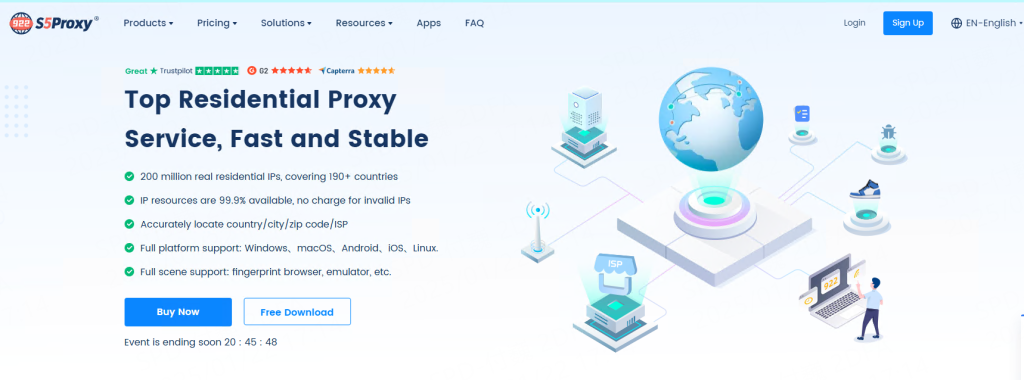In the Internet age, IP addresses are the unique identifiers of each device accessing the Internet. With the growing demand for network security, privacy protection, and online activities, IP address rotation technology has emerged.

Overview of IP address rotation
Before understanding IP address rotation, you first need to clarify what an IP address is. An IP address is a digital label that uniquely identifies a device connected to the Internet. There are two main types: IPv4 and IPv6. IPv4 is a traditional standard that provides a limited address space, while IPv6 solves this limitation with a larger address range.
IP address rotation is a technology that timed changes the IP address of a device or server to improve network security. By frequently changing the address, the risks that may arise from using the same address for a long time can be reduced.
Application scenarios of IP address rotation
IP address rotation (IP Rotation) has a wide range of applications in multiple fields, especially in scenarios where incognito needs to be improved, restrictions need to be circumvented, or network performance needs to be optimized. The following are its main application scenarios:
Network privacy protection: Prevent tracking and positioning by hiding the real IP address of the device.
Data collection and web crawlers: Bypass the access restrictions or IP blocking of the target website.
Ad verification: Simulate users in different regions to verify the coverage and effect of advertising.
Load balancing: Distribute network traffic and improve service stability and access speed.
By changing IP addresses regularly, users can not only effectively avoid potential security threats, but also improve incognito efficiency!
Common methods for implementing IP address rotation
IP address rotation can be implemented through a variety of technologies and tools, mainly based on user needs and technical architecture. The following are several common methods for implementing IP address rotation:
1.Use proxy servers
Proxy servers are one of the most common ways to implement IP rotation. Users can automatically switch IP addresses through proxy pools. There are usually two types of proxies:
Shared proxy: Multiple users share the same proxy IP. This method is low-cost, but there may be speed and stability issues.
Dedicated proxy: Each user has an independent IP, with high speed and stability, suitable for application scenarios with high performance requirements.

922Proxy is a well-known platform that provides high-quality proxy IP services, allowing users to rotate IPs through proxy pools. 922Proxy provides a large number of IP resources, and users can choose different IP types (such as residential IPs) as needed, and automatically switch IPs through APIs or tools.
Implementation method:
Purchase multiple IP proxy services, such as 922Proxy, and switch proxy IPs regularly.
Use proxy management tools or API interfaces (such as the API provided by 922Proxy) to implement IP rotation.
2.Dynamic IP address allocation (DHCP)
Some Internet service providers (ISPs) provide dynamic IP address allocation (DHCP), which means that the user’s IP address will change every time you connect to the Internet. For corporate or home users, this method is relatively simple to implement.
Implementation method:
Every time you disconnect and reconnect to the network, the ISP will assign a new IP address to the user.
If the ISP supports it, you can request dynamic IP address allocation to achieve IP rotation.
3.Cloud service and load balancing
For enterprise-level applications, using cloud service platforms and load balancers to allocate IP addresses is also a common implementation method. By distributing traffic among multiple servers or data centers, the effect of rotating IP can be achieved.
Implementation method:
Use the elastic IP or load balancing function of cloud service platforms (such as AWS, Azure, Google Cloud, etc.) to automatically expand and adjust traffic and allocate different IPs.
Configure policies on the load balancer to regularly switch traffic source IPs according to demand.
4.Self-built IP rotation system
For users with higher technical requirements, this can be achieved by self-built IP rotation system. Build an automated IP rotation system by integrating multiple proxies, servers or cloud services.
Implementation method:
Configure multiple proxy servers or cloud servers and implement automated rotation through scripts.
Use API or custom code to regularly switch server IPs and manage the use of different IPs.
5.Use Tor network
Tor is an anonymous communication network that hides the user’s IP address through multiple layers of encryption and transmission of multiple nodes. By using the Tor network, users can achieve IP address rotation, thereby improving incognito and security.
Implementation method:
Install and configure the Tor client to automatically rotate IP addresses through Tor nodes.
Use Tor’s “Exit Node” function to specify the exit node and control the source of the IP.
6.IP rotation tools and scripts
Some developers can write custom scripts to switch IPs regularly, especially in combination with proxy pools or cloud servers. Common tools include Scrapy (Python crawler framework), 922Proxy, and brightdata.
Implementation method:
Develop and deploy automated scripts to switch IPs regularly.
Use open source tools or API interfaces to quickly implement IP rotation functions.
How to rotate IP addresses efficiently
To ensure the efficiency of IP address rotation, here are some suggestions and tips:
Choose the appropriate rotation frequency: The frequency of rotation should be based on demand. For example, for crawler tasks that need to run for a long time, a high rotation frequency may affect the incognito of the task; while for bypassing simple anti-crawler mechanisms, a higher rotation frequency will be more effective.
Use reliable proxies: Choose a proxy service provider with stable performance to avoid unstable connections or service interruptions caused by too frequent IP address switching.
Consider the size of the IP pool: The size of the IP address pool affects the effectiveness of the rotation. A larger pool provides more options and helps avoid IP addresses being marked as malicious or blocked.
Regional restrictions: if you want to bypass regional restrictions, choose a proxy that provides multiple regional IP addresses. It can simulate different IP locations and effectively access restricted content.
Comparative Analysis of IP Rotation and Proxy Servers
Although IP address rotation and proxy servers are often used together, there are some differences in their concepts and working methods:
Proxy server: A proxy server is a solution that is accessed through an intermediary device and can achieve IP change. Proxies usually provide simple anonymity, mainly by hiding the user’s real IP address to avoid being tracked.
IP address rotation: IP rotation is not just changing proxy servers, but also includes regular changes of IP addresses, which are usually done automatically. This means that during the rotation process, users’ network activities and access patterns are more unpredictable.
Flexibility and efficiency: Proxy servers usually need to be switched manually, while the automation and flexibility of IP rotation can better cope with complex needs, especially in the fields of crawlers and data scraping.
Conclusion
IP address rotation is an effective technical means to improve incognito, security and flexibility in a variety of application scenarios. Whether it is used for crawling, anonymous browsing, or bypassing Regional restrictions, IP rotation can effectively solve the problem. When implementing it, choosing the right tools and services, reasonably configuring the rotation frequency, and using a reliable proxy pool will help users maximize the advantages of IP rotation.



